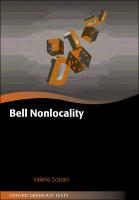Bell Nonlocality
Author(s)
Scarani, Valerio
Collection
SCOAP3 for BooksLanguage
EnglishAbstract
Nonlocality was discovered by John Bell in 1964, in the context of the debates about quantum theory, but is a phenomenon that can be studied in its own right. Its observation proves that measurements are not revealing pre-determined values, falsifying the idea of “local hidden variables” suggested by Einstein and others. One is then forced to make some radical choice: either nature is intrinsically statistical and individual events are unspeakable, or our familiar space-time cannot be the setting for the whole of physics. As phenomena, nonlocality and its consequences will have to be predicted by any future theory, and may possibly play the role of foundational principles in these developments. But nonlocality has found a role in applied physics too: it can be used for “device-independent” certification of the correct functioning of random number generators and other devices. After a self-contained introduction to the topic, this monograph on nonlocality presents the main tools and results following a logical, rather than a chronological, order.
Keywords
Nonlocality, Bell’s theorem, John Bell, quantum entanglement, Einstein-Podolsky-Rosen, device-independent, quantum foundations, local hidden variables, local realism, spooky actionDOI
10.1093/oso/9780198788416.001.0001ISBN
9780198788416Publisher
Oxford University PressPublisher website
https://global.oup.com/Publication date and place
2019Grantor
Series
Oxford Graduate Texts,Classification
Quantum physics (quantum mechanics and quantum field theory)
Particle and high-energy physics
Computer science


 Download
Download Web Shop
Web Shop